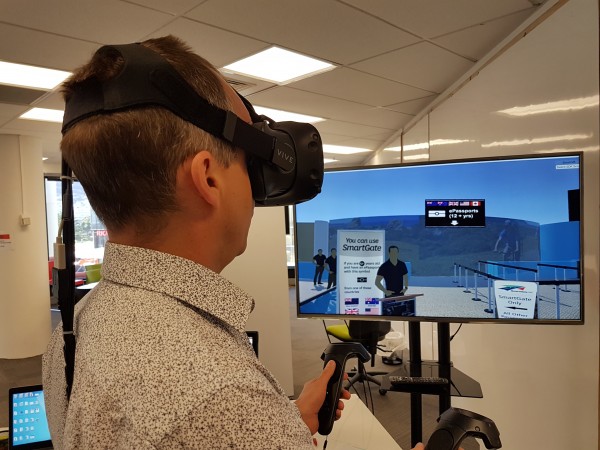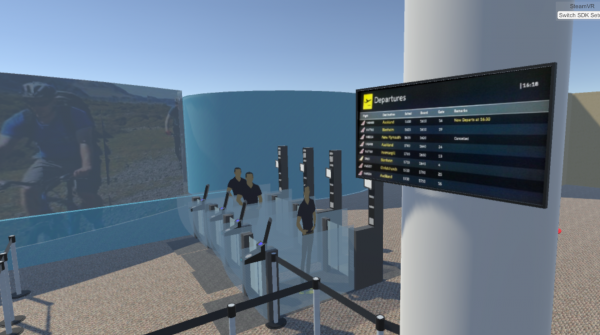Changes to layout, floor space, signage, the introduction of new kiosks and increased passenger numbers combined to present an opportunity for the NZ Customs Service to make the traveller experience in the international departure area at Christchurch International Airport a lot more pleasant and efficient.
But the process of service design and implementation within the environment of a working airport can be hard to manage without disruption to staff and customers.
A previous project attempting to redesign and improve the departures area layout took 18 months to complete testing.
Thanks to Virtual Reality (VR) technology, the NZ Customs Service was able to undertake a project in partnership with businesses Assurity Consultancy, Corvecto, Christchurch International Airport and fellow government agency Aviation Security — all within an eight week timeframe, and with 'no-to-low' impact on day-to-day users.
This allowed 100 customers to trial and test new layouts within a virtual airport environment.

How it worked
Although VR has been around for a number of years, its commercial usage is new and innovative.
As a user-research tool, it is cutting-edge and shows huge potential.
The immersive environment VR creates allows the researcher to simulate real life experiences and provoke an emotional response that cannot be replicated by other research methods other than field studies.
Being able to simulate an environment allows great agility, and can target a diverse range of customers that field studies may not give the researcher access to. In a secure environment such as the departures area at Christchurch International Airport, it meant it did not interfere with business as usual.
This user-research engagement used a VR simulation of the Christchurch International Airport departures area and mock-ups of potential variations of the area.
The insights from a previous crowd testing study helped to form an initial baseline understanding of how people perceive the symbols, signs, and layouts of the current Christchurch International Airport international departures area.
This project utilised an application built by Corvecto for use with the HTC Vive.
Using VR for user-research allowed for an immersive experience of the departures process for participants. The user scenarios and environment were constructed to capture the spirit of the experience. Twenty-nine participants took part in this research. They held passports from 10 different countries. Some participants were dual passport holders with New Zealand being one of their nationalities. Users were exposed to three environments, each with a different layout of the Customs departure area.
The facilitator would read out a scenario that would best relate to the participant, and from there, for the duration of the experience, the participants were encouraged to 'think out loud' and express how they felt about their surroundings, the layout, and the placement of the signs. Where appropriate, the facilitator would ask open questions to prompt further insights.
The purpose of this study was to build an understanding by immersing participants in a simulated environment and asking them to provide feedback on signage and their experience as they navigated through the three test layouts. The results from both studies contributed to the redevelopment of the departures area, improving the overall customer experience of leaving Christchurch International Airport as well as resolving some operational issues for NZ Customs Service officers. The combined ability to crowdsource, apply co-design methods and use VR technology also allowed valuable research to be made available to other relevant projects, reducing the need to duplicate work effort and cutting costs. The pilot team was able to create better engagement and strengthen current relationships, resulting in improved, joined up services for our customers through further prospective cross-agency work.
This was the first time VR has combined with crowdsourcing to create this type of virtual airport experience, and it has been used as a case study and example at a user experience (UX) meeting recently held in Wellington.
Further opportunities for use
VR technology will help the NZ Customs Service achieve their strategic objectives. The technology will allow both agility and flexibility when enhancing services with a customer focus through using service design methodology and co-designing within the NZ Customs Service, external businesses and customers.
By enhancing these services, the NZ Customs Service is making it easier for customers to comply and contribute towards the modernisation of the border.
This will have a positive impact on how we collect information and continue to be an intelligence-led organisation.
VR technology can be used across numerous channels and business initiatives. The software can be adapted to any environment, whether it be the International Mail Centre, an airport environment or staff training programmes. Using VR means, once it has been programmed, it's available, and isn't reliant on a person's experience or time to train other staff.
VR can be used in the development of process improvement. It can effectively design layouts and processes that can be tested without impeding our staff or customers, as there is no dependency on someone being physically present in the area concerned.

This initiative was created as part of the Better for Business collective.
Better for Business: 10 agencies— one vision
